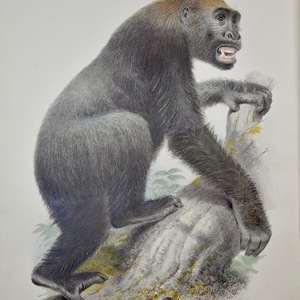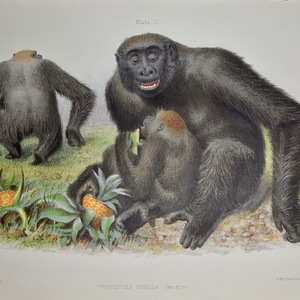-
Title
-
Memoir on the gorilla : (Troglodytes gorilla, Savage)
-
Caption
-
English taxonomist and paleontologist Richard Owen (1804-1892) published Memoir on the Gorilla only nine years after Paul Belloni Du Chaillu became the first European to confirm the existence of gorillas in the wild during his expedition to Gabon in 1856. Owens – famous for having taught natural history to Queen Victoria’s children, his quarrels with famed naturalist Charles Darwin, and for naming a new taxon of large extinct reptiles – Dinosauria – in 1842 – wrote the first complete anatomical description of gorillas using several preserved specimens collected by Du Chaillu. Despite his anatomical accuracy, Owen’s anti-Darwinian views led him to erroneously state that gorillas lack certain parts of the brain that humans have, specifically a structure called the hippocampus minor, citing this as evidence that humans could not possibly be related to apes. Owens also erred in his account of the gorilla’s behaviors, reflecting the fear and misunderstanding of great apes that later led to their frequently being killed by thrill-seeking hunters and poachers in the late 19th and early 20th centuries. On page 35, Owens writes “Lacerations of the abdomen and laying bare of the intestines of a hunter are described as the effects of a blow of… the Gorilla… Mr. Du Chaillu also adduces the testimony of the natives, that, when stealing through the gloomy shades of the tropical forest, they become sometimes aware of the proximity of one of these frightfully formidable Apes by the sudden disappearance of one of their companions, who is hoisted up into the tree, uttering perhaps, a short choking cry. In a few minutes he falls to the ground a strangled corpse.” Even as primatologists later disproved these harmful perceptions of gorillas, gorilla numbers across Africa declined dramatically over the last century due to destruction of habitat from agricultural expansion and timber harvest, poaching, war and political unrest, and human disturbance. Today, all gorilla subspecies are classified as “Endangered” according to the International Union for Conservation of Nature’s (ICUN) criteria. However, dedicated conservation initiatives have ensured that gorilla numbers are now slowly increasing. Innovative new conservation ideas, including remotely monitoring gorilla movement and spreading awareness of the dangers of consuming bushmeat have shown some success in slowing gorilla population declines. In fact, the World Wildlife Fund recently announced that mountain gorilla numbers have increased to above 1,000 individuals for the first time in decades due to conservation efforts. Traditional protected areas are still one of the main conservation strategies to address threats such as hunting and habitat loss, however new tactics including working directly with logging companies and local communities to regulate the bush meat trade have also helped to reduce hunting pressure. If gorillas are to be conserved into the future, a combination of national parks, reducing human conflict, and working with local farmers and loggers will all be essential tools for maintaining viable populations.
-
Creator
-
Richard Owen
-
Date Created
-
1865
-
Publisher
-
Taylor and Francis
-
Place of Publication
-
London, England
-
Rights
-
No Known Copyright
-
Bibliographic Citation
-
Owen Richard. Memoir on the Gorilla : (Troglodytes Gorilla, Savage). London: Taylor and Francis, 1865. Rare Book QL737.P9 O8




